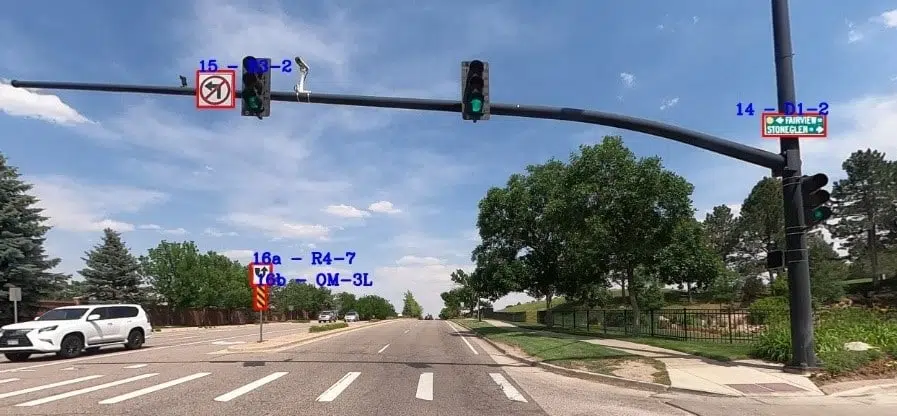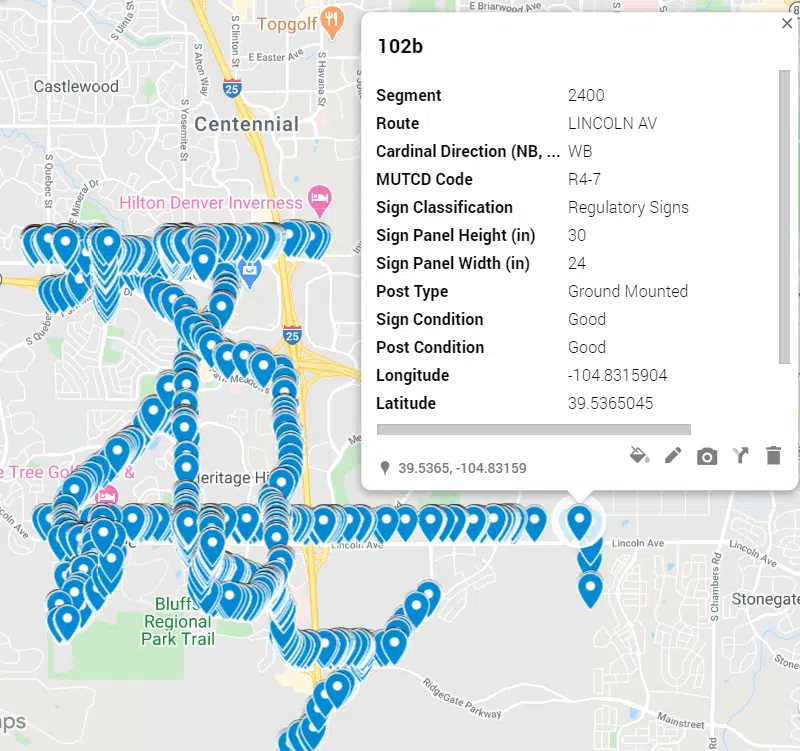- March 25, 2021
- Case Studies, Perspectives, Trending Topics
Traffic Sign Inventory and Condition Assessments Get Smarter With Artificial Intelligence


Kathy Keegan, PE
Pavement Engineer

Tim Miller, PE
Pavement Engineer

Scott Sounart, PE
Pavement Engineer
Kimley-Horn supports many roadway agencies across the U.S. through transportation asset management consulting services, helping them maintain and improve their infrastructure networks. This process typically involves asset inventory, condition evaluation, performance prediction, treatment selection, prioritization, and optimization of budget allocation. Through this data-driven process, Kimley-Horn’s traffic engineers provide decision-makers with short- and long-term maintenance and capital improvement plans.
Condition assessments and asset inventory are now being taken to a new level of efficiency using artificial intelligence (AI). Using iENGINEERING’s transportation engineering software, Transconomy, Kimley-Horn created a traffic sign inventory and condition database for the City of Lone Tree, Colorado.
Selecting a System: Using AI for Rapid Image Processing
Transconomy automates and accelerates data processing activities, automatically detecting and classifying:
- Traffic signs in accordance with the Federal Highway Administration’s Manual for Uniform Traffic Control Devices (MUTCD);
- Point assets such as light posts, utility poles, and fire hydrants;
- Line assets such as guardrails, medians, and barriers; and
- Many other asset types.

Transconomy proved to be a beneficial software system for the City of Lone Tree when in addition to traditional automated collection methods for the City’s pavement inventory, Kimley-Horn was asked to collect imagery and perform condition assessments for over 4,000 traffic signs within the City’s boundary. The City was interested in establishing a baseline inventory of the signs, including initial condition assessments on a 1 to 4 scale, with associated and geotagged imagery for each sign.
Due to the project location’s proximity to an airport, the layout of adjacent neighborhoods, and COVID-19 concerns, imagery was not allowed to be collected via drones or LIDAR methods. Utilizing a robust machine learning software system and careful, yet rapid processing of thousands of images, we were able to provide the City with the basis for a sign inventory, allowing them to forecast annual budgeting for sign repairs and replacements.
Capturing, Analyzing, and Exporting Robust Image Data Sets
Kimley-Horn collected about 100 lane-miles of street imagery using a GoPro camera. Nearly 50,000 images were then uploaded to the cloud, where the Transconomy AI algorithm was executed. These raw images were automatically processed to identify assets, remove duplicate assets in consecutive images, and geotag asset locations on a map. The software provides the GIS-based asset inventory in SHP for use in Esri applications and KML files for use in Google applications.

The team also used a semi-automated approach to determine the condition of sign faces and signposts for this project. In addition to the GIS files, all data were also delivered in a CSV file format to the City for full visibility and improved record keeping.

“The project team was responsive to the needs, concerns, and wishes of the Lone Tree community, including our internal stakeholders. The team’s skilled and dedicated professionals have provided exceptional service to the City.”
— City of Lone Tree
Automated condition assessments and asset inventory are safer and more efficient, using today’s available AI technology. To learn more about how our experts and technology can help with your asset management needs, contact Kathy Keegan, Tim Miller, or Scott Sounart or submit a service inquiry.
About the Authors

Kathy Keegan, PE
Kathy has more than 27 years of pavement management and design experience working across many transportation sectors including municipalities, Departments of Transportation, airports, and automotive, port and intermodal sites. She has dedicated her career to assessing pavement conditions and developing capital improvement plans resulting in increased budgets and funding for pavement owners.

Tim Miller, PE
Tim has more than 15 years of experience in transportation asset management, pavement engineering, and project delivery. He focuses on utilizing innovative technologies to deliver impactful, data-driven pavement management programs for public agencies, Departments of Transportation, the Department of Defense, and aviation clients. Tim’s participation in the Transportation Research Board and industry working groups has helped to position Kimley-Horn as an industry leader in leveraging technology for pavement and asset management programs.

Scott Sounart, PE
Scott is an expert on hot mix asphalt and related pavement engineering technologies. He has more than 29 years of experience in the design, management, and construction of roadways, bridges, and airports and coordinated several research projects related to aggregates and asphalt paving materials, conducted forensic evaluations, and provided expert witness services. His other areas of specialization include pavement evaluation studies and designs, pavement and asset management implementations, and distress data collection methods for local and state agency, aviation, and rail clients.
